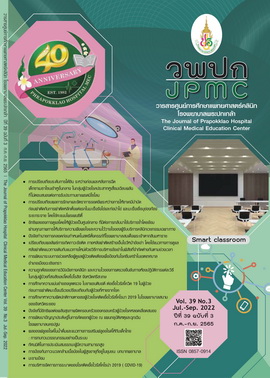Sarcopenia Prevention in Elderly Community Dwellers: Nurses’ Roles
Main Article Content
Abstract
Sarcopenia is common in older adults (geriatric syndrome) resulting from age-related deterioration in the body. It was found that the risk factors of having sarcopenia were increased age, malnutrition, low body mass index, low physical activity, chronic illness, and inappropriate health behavior. All these factors led to an increase in sarcopenia, illness, and limited mobility, which was a potential risk that could lead to falls. Furthermore, the decrease in daily activities together with frailty increased the burden of the healthcare costs and decreased the quality of life. However, physical activities combined with the promotion of proper nutrition could reduce the risk of sarcopenia. Therefore, the roles of nurses should take into account the assessment of the risk of this syndrome and screening the lifestyle health behavior of older adults, so to draft well-planned guidelines to prevent sarcopenia. This should also include encouraging older adults to have continuous physical activity in order to maintain their abilities to help themselves and have a good quality of life.
Article Details

This work is licensed under a Creative Commons Attribution-NonCommercial-NoDerivatives 4.0 International License.
References
Kim E, Sok SR, Won CW. Factors affecting frailty among community-dwelling older adults: a multi-group path analysis according to nutritional status. Int J Nurs Stud [Internet]. 2021 [cited 2021 Aug 4];115:103850. Available from: https://linkinghub.elsevier.com/retrieve/pii/S0020-7489(20)30341-2
Therakomen V, Petchlorlian A, Lakananurak N. Prevalence and risk factors of primary sarcopenia in community-dwelling outpatient elderly: a cross-sectional study. Sci Rep [Internet]. 2020 [cited 2022 Mar 29];10(1):19551. Available from: https://www.nature.com/articles/s41598-020-75250-y
Sato PHR, Ferreira AA, Rosado EL. The prevalence and risk factors for sarcopenia in older adults and long-living older adults. Arch Gerontol Geriatr [Internet]. 2020 [cited 2021 Aug 15];89:104089. Available from: https://www.sciencedirect.com/science/article/abs/pii/S0167494320300832?via%3Dihub
Veronese N, Smith L, Barbagallo M, Yang L, Zou L, Haro JM, et al. Sarcopenia and fall-related injury among older adults in five low- and middle- income countries. Exp Gerontol [Internet]. 2021 [cited 2022 Mar 31];147:111262. Available from: https://www.sciencedirect.com/science/article/abs/pii/S0531556521000371?via%3Dihub
Kulchanarat C, Yuenyongchaiwat K. Prevalence of sarcopenia in heart failure and its associated factors: a systematic review. Vajira Medical Journal: Journal of Urban Medicine 2020;64:333-44.
Papadopoulou K. Sarcopenia: a contemporary health problem among older adult populations. Nutrients [Internet]. 2020 [cited 2020 Jan 1] 12(5):1293. Available from: https://www.ncbi.nlm.nih.gov/pmc/articles/PMC7282252/pdf/nutrients-12-01293.pdf
Wongpipit W, Kritpet T, Phongphibool S. Physical activity and sedentary behavior: guideline and assessment. Journal of Sports Science and Health 2020;21:1-21.
Duangjina T, Panuthai S. Nursing intervention for improving nutritional status in older persons. Nursing Journal 2020;47(3):469-80.
Prokopidis K, Witard OC. Understanding the role of smoking and chronic excess alcohol consumption on reduced caloric intake and the development of sarcopenia. Nutr Res Rev [Internet]. 2021[cited 2022 Sep 3]:1-10. Available from: https://www.cambridge.org/core/journals/nutrition-research-reviews/article/understanding-the-role-of-smoking-and-chronic-excess-alcohol-consumption-on-reduced-caloric-intake-and-the-development-of-sarcopenia/4C6601C4211F10DFDD4C0382A1A42095
Limpawattana P, Manjavong M. Clinical practice for sarcopenia. KKU J Med 2020;6(2):7-16.
Chen LK, Woo J, Assantachai P, Auyeung TW, Chou MY, Iijima K, et al. Asian Working Group for Sarcopenia: 2019 Consensus update on sarcopenia diagnosis and treatment. J Am Med Dir Assoc 2020;21:300-7.e2.
Kaewkaen K. Assessment of physical performance in elderly with short physical performance battery test. J Med Health Sci 2019;26(2):96-111.
Khampalikit S, Arpanantikul M, Chinuntuya P. Health prevention: nurse role. Nonthaburi: Mata Karnphim; 2016.
Escriche-Escuder A, Fuentes-Abolafio IJ, Roldán-Jiménez C, Cuesta-Vargas AI. Effects of exercise on muscle mass, strength, and physical performance in older adults with sarcopenia: A systematic review and meta-analysis according to the EWGSOP criteria. Exp Gerontol [Internet]. 2021[cited 2022 Apr 1];151:111420. Available from: https://www.sciencedirect.com/science/article/abs/pii/S0531556521002023?via%3Dihub
Chomwattanachai S, Niamhom S, Duangdee S, Permbotasi T. The effectiveness of resistance exercise in elderly with sarcopenia: a systematic review. Journal of the Department of Medical Services 2019;44(1):47-51.
Ganapathy A, Nieves JW. Nutrition and Sarcopenia-What Do We Know? Nutrients [Internet]. 2020 [cited 2022 Apr 1];12(6):1755. Available from: https://www.ncbi.nlm.nih.gov/pmc/articles/PMC7353446/

